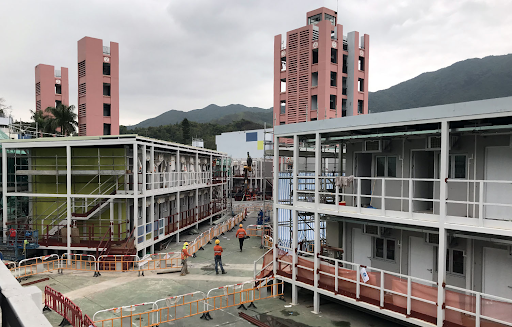The COVID-19 pandemic has made us rethink the capabilities of our existing infrastructure. Be it healthcare, building construction, or retail, every sector of the economy has undergone a functional reform. Innovation and technology have played a major role in shaping this transformation. The most significant change that this pandemic has ushered is the norm of social distancing. It has forced people to stay indoors and maintain contact-less communication with the world. Highly populated countries such as China and India have combated the infection with the help of effective strategies such as the “Test- Trace- Isolate- Treat” policy. Emergency facilities have been set up to endure the pressure on global medical resources and by extension, medical personnel.
The Need for Quarantine Centres
The outbreak of the COVID-19 pandemic overwhelmed the global healthcare system. The spread of the virus was so quick that it infected a huge section of the world population, all at once. This made it difficult to have enough room in hospitals across the globe for every infected person. The need for social distancing enforced by the pandemic further escalated the difficulty of accommodating patients in a hospital room to its full capacity. Thus healthcare was only available to those patients who required immediate medical attention. People with mild infection symptoms had to quarantine themselves at home or at public institutes to restrict/restrain the transmission of the virus.
Alongside, the pandemic brought the world to a standstill only after witnessing the initial wave of mass migration. While the corporate sector shifted to the module of remote working, the daily wage workers and unskilled labour found themselves at a loss of jobs. With such a shift in work culture and availability, people migrated from metropolitan cities back to their hometowns to reside in the comfort of their homes amidst the uncertainty created by the pandemic. However, considering the contagious nature of the COVID-19 virus, it became necessary to isolate these people at the city outskirts/ town limits in order to keep the virus from spreading. This further pushed the need for having dedicated quarantine facilities to ease the stress on the existing healthcare system. Architects have come to the forefront with design innovations to help in the development of such quarantine centres.
What are Temporary Quarantine Centres?

Governments around the world initially resorted to assigning public buildings such as indoor stadiums to be used temporarily as emergency quarantine facilities. In spite of this, the need for use-specific quarantine facilities was felt because of the lightning speed with which the virus was spreading. Thus, temporary quarantine structures were considered a viable solution to this issue. Every country has set guidelines for the design of Quarantine Facilities based on global standards. For instance, the Government of India has issued a guideline that describes the access, design standards, and requirements of its Quarantine Facilities.
A temporary Quarantine Centre can thus be defined as a makeshift isolation facility for people who are highly susceptible to being virus carriers. The purpose of these centres is to limit the introduction of this infectious disease into the community. These are structures built due to emergency needs and are therefore non-permanent. They are typically designed to be flexible and fast assembling. Wood, steel, and plastic are the most widely used construction materials for such temporary quarantine centres.
Design of Quarantine Centres

Most architects followed the idea of developing a prototype and then replicating it to develop the site for the Quarantine Centre. Hence, the design of these Centres is usually modular in nature. Simple structural design and joinery with rectilinear form is the general module of a Quarantine Centre.
The Sai Kung Outdoor Recreation Centre in Hong Kong is an excellent example that resembles this stereotypical design. The design and construction of this Centre were completed in 2 and half months. The module was factory-assembled and was installed on-site which made it easier to be constructed in the expected timeline. The module was replicated over three storeys which are further reproduced into 3 blocks. The facility has been designed and executed by LWK & Partners. They have designed the module to be reusable which makes it a sustainable design.
Another great example of quarantine faculty is from the United States where the WTA Design Studio has set up 60 emergency quarantine facilities. A pavilion near this facility has been repurposed as a short-term relief space. Yet again, the facility is built by replicating modules of built-in wood and plastic.
Alongside, many conceptual designs have been proposed across the globe to isolate and treat COVID-19 infected patients. JUPE HEALTH has designed mobile units which are Intensive Care Units (ICUs) on wheels. They are cost-effective and available at 1/30th of the cost of a hospital bed. JUPE is the first standalone ICU invented by Jeff Wilson and Cameron Blizzard to decrease the stress on hospitals across the United States. This mobile ICU can be folded, packed, and deployed anywhere to serve as an emergency resource.

In India, the construction of such temporary quarantine centres can be seen in Mumbai where the NESCO grounds at Goregaon has been converted into a quarantine centre and can accommodate up to 2000 people. Originally used as an exhibition space, the grounds are now staging hospital beds, helpdesks, sanitization equipment, inquiry booths and testing stations.
Another exemplary quarantine facility design has been presented by the Italian architect, Carlo Ratti. He has converted shipping containers into intensive-care pods. They are mobile units that can be rapidly mounted in times of healthcare emergency crises such as the COVID-19 pandemic.
Thinking out of the conventional frame has helped designers to provide instant solutions to quarantine requirements. Spatial reorganization and availability have been the biggest challenge in condemning the virus and it has been dealt with the best design approaches. It has made the world realize the importance of fast thinking and implementation. These quarantine centres will serve as an excellent case study for any future health crisis across the globe.
Source:
- Alternative Healthcare Facilities: Architects Mobilize their Creativity in Fight against COVID-19
- Manila-Based Architecture Firm Designs Temporary Quarantine Facilities
- 10 Examples of innovative temporary quarantine centres
Disclaimer: The information contained herein have been compiled or arrived at, based upon information obtained in good faith from sources believed to be reliable. The opinions expressed within the content are solely the author’s and can be subject to change. The image featured in this article is only for illustration purposes. If you wish the article to be removed or edited, please send an email to editor@biltrax.com
Discover more from Biltrax Media, A Biltrax Group venture
Subscribe to get the latest posts sent to your email.





















